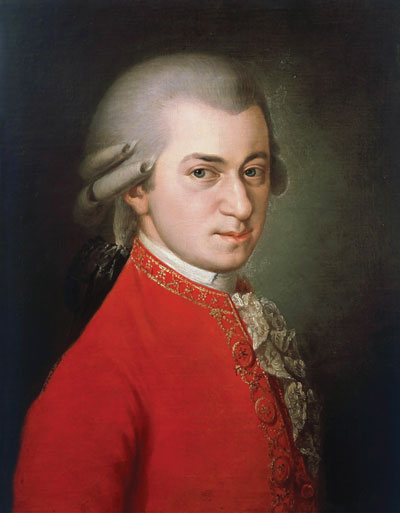Wolfgang Amadeus Mozart

Born: January 27, 1756, in Salzburg, Austria
Died: December 5, 1791, in Vienna, Austria
Serenade No. 10 in B-flat Major, K. 370a (362), Gran Partita
- Composed: likely 1783-1784
- Instrumentation: 2 oboes, 2 clarinets, 2 basset horns, 2 bassoons, contrabassoon and 4 horns
In his brilliant piece of stagecraft Amadeus, author Peter Shaffer chose to make the exquisite slow movement of the B-flat major Serenade the linchpin, the catalyst, to set in motion his searing drama. Antonio Salieri, court composer to Emperor Joseph II, had built a distinguished career for himself in Vienna while closely guarding his belief that he was just a poseur, his music technically proficient but emotionally shallow. The sound of Mozart’s Adagio, music such as Salieri could never create, virtually shattered his reason: “It started simply enough: just a pulse in the lowest registers—bassoons and basset horns—like a rusty squeezebox. It would have been comic except for the slowness, which gave it instead a sort of serenity. And then suddenly, high above it, sounded a single note on the oboe. It hung there unwavering, piercing me through, till breath could hold it no longer, and a clarinet withdrew it out of me, and sweetened it into a phrase of such delight it had me trembling. The light flickered in the room. My eyes clouded! The squeezebox groaned louder, and over it the higher instruments wailed and warbled, throwing lines of sound around me—long lines of pain around and through me.... The pain cut deeper into my shaking head, until suddenly I was running into the street, into the cold night, gasping for life.... What is this pain? What is this need in the sound? Forever unfulfillable, yet fulfilling him who hears it, utterly. I was suddenly frightened. It seemed to me that I had heard a voice of God.”
The date of composition of the B-flat Serenade (K. 361) is the subject of ongoing debate. Ludwig Köchel, in his pioneering chronological catalog of Mozart’s works published in 1862, assigned the Serenade to 1780, according to a date on the manuscript that has since been shown to have been altered by an unknown hand. (Nor was the familiar sobriquet “Gran Partita” at the head of the manuscript written by Mozart.) In his 1937 revision of Köchel’s catalog, Alfred Einstein changed the date to 1781 because he read the final, smudged character on the manuscript as a “1.” That speculation seemed to be substantiated by Alan Tyson’s exhaustive study in the 1980s of the watermarks of Mozart’s manuscript paper. (Hermann Abert’s 1924 biography of Mozart suggested, apparently incorrectly, that the composer used the Serenade as the entertainment music for his own wedding reception, on August 4, 1782.) However, extensive subsequent research by Daniel N. Leeson (including a 168-page monograph on K. 361 published in 2009) has led to late 1783 and/or early 1784 now being widely accepted as the time of the work’s origin. On the basis of stylistic, biographical and historical evidence, Leeson argued that the Serenade was commissioned by Anton Stadler, clarinetist in the court orchestra and a fellow Freemason for whom Mozart later wrote the Kegelstatt Trio (K. 498), Clarinet Quintet (K. 581) and Clarinet Concerto (K. 622), for his concert at Vienna’s Burgtheater on March 23, 1784. Of that event—the only time this magnificent music was known to have been performed during Mozart’s lifetime—playwright Johann Friedrich Schink wrote, “I have heard a piece for wind instruments by Herr Mozart today. Magnificent! It employed thirteen instruments and at every instrument a master. The effect was grand and magnificent beyond description.” Listeners’ response, unaffected by the scholarly sparring over the work’s date, has not varied since.
The burnished sonority of the B-flat Serenade, scored for pairs of oboes, clarinets, basset horns (Mozart’s first use of the new alto clarinet) and bassoons, four horns and double bass or contrabassoon, is one of the most ingratiating to be found anywhere in the ensemble literature. “No master ever handled a large body of wind players with such wondrous results,” wrote John N. Burk. Concertante elements—the contrasting of solo instruments (or, here, pairs of like instruments) with the full ensemble—bring a kaleidoscopic range of timbral colors to the work’s seven movements. The Serenade opens with a stately slow introduction that prefaces a full sonata-form movement. The second and fourth movements are minuets, the first city-graceful, the second country-rustic. As befits the expansive nature of the work (the longest chamber composition in Mozart’s output, rivaled only by the Clarinet Quintet, K. 581), both minuets are supplied with not one but two trios. Enfolded between these movements is the transcendent Adagio, which drew from Alfred Einstein some of the most rapturous words in his classic 1945 study of Mozart: “a Notturno...a scene from Romeo and Juliet, under starry skies, a scene in which longing, grief and love are wrung like a distillation from the beating hearts of the lovers.” The fifth movement is a Romance with a center section of quick motion and unsettled mood. The Theme and Variations is a reworking of the finale of the C major Flute Quartet (K. 285b) of 1778. A sparkling Rondo—what the Germans would call a Kehraus, literally a “sweeping out” at the end of a social evening—concludes this wonderful and richly varied masterwork.
—Dr. Richard E. Rodda